Five ways to handle old hens
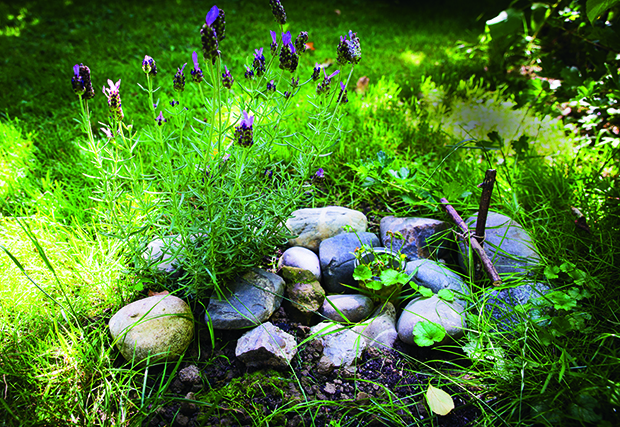
What to consider when it’s time to retire old hens.
Words: Andrea Graves
Most of us love our chickens and dread having to end their lives. But how to do it? When to do it? I have had to grapple with these practical questions – as well as the emotions that come with them – ever since I started keeping chickens. There are many different reasons why you’d be compelled to end a chicken’s life. It might be because you want chicken for dinner that night. Or perhaps your chicken has stopped laying eggs and you need to make space. I have killed unwell birds that are suffering and I think have no chance of recovery. While you can take a sick hen to the vet, there’s sometimes no way of knowing whether the extra day you keep her alive will be the day she’ll start to recover – or whether it’s an unnecessary extra day of suffering. No matter the reason, ending a hen’s life is seldom easy. So how can we make the process as painless and constructive as possible?
1. EGGS AND EMPATHY
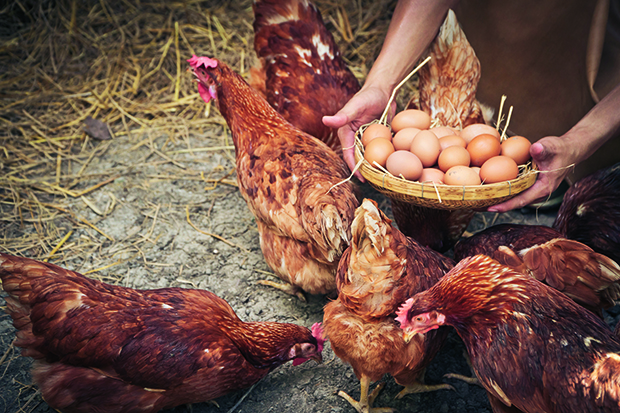
I dispatch my chickens when they stop giving me a decent supply of eggs. With the commercial laying breeds – hylines and brown shavers – this tends to be after two or three years. They might still be laying in spring, but the eggs are not abundant.
Is that really a justifiable reason to kill? I’ve received flak on my Facebook page for this approach. Some people love their own chickens so much they could never kill them. Many people do it
but hate it, and I’m one of them. But if you live on a small section, you can’t just add a few fertile pullets to your flock without making room.
Because I keep chickens for their eggs, it’s easier for me to justify killing and replacing them when I consider alternative egg sources. If I kept my older non-laying chickens and ran out of space, I would probably need to purchase eggs from the supermarket. But then I’d be participating in a large-scale farming model, which certainly involves the death of many animals.
On this basis, I think a swift, stress-free death at home, perhaps after a last meal of silverbeet, is kinder to chickenkind as a whole than buying into industrial egg production. But if I ever go completely vegan, I’ll keep my last chickens until illness or old age takes them.
2. EMOTIONAL FORTITUDE
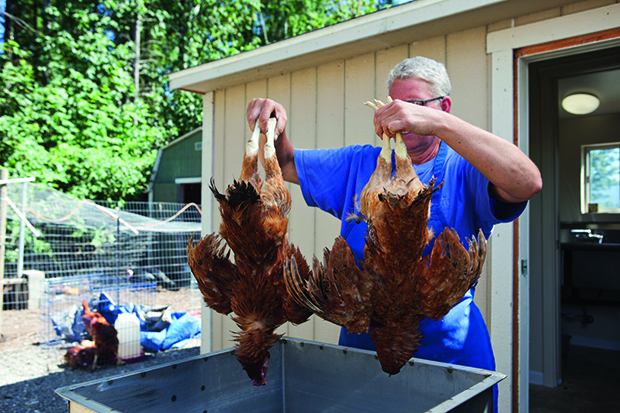
When the time comes to do the act, you need emotional fortitude as well as technique. The softy inside you might cry “no!” while the logical part says “but you must”. Then, if you’re like me, you find a reason to delay anyway.
I know a man who dreaded killing his chickens, but they were destined for the table and the slaughter was required. When the dreaded day of death came, he always put off the act. But someone else knew what was up. The household cat hung around the man all day, as it had learnt that when he moped like that, a tasty chicken head was imminent.
It’s okay to acknowledge that you might hate killing your bird, but you need to squash that feeling until your bird’s doing her death spasms. Chickens, like other animals, sense when you are calm and it helps them be calm – even if you’re only pretending.
3. THE ACT
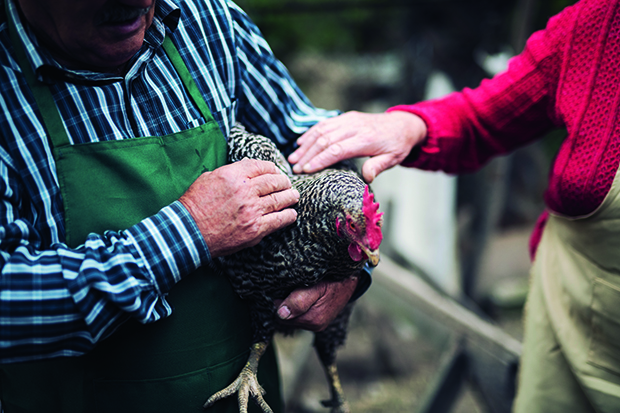
When the time comes, set up anything you need out of sight of the other chickens. In a friendly and casual manner, pick up your chicken. Take her to the place you’ve chosen. Soften your body and breathing.
There are several ways to kill a chicken. These vary depending on how long it takes for the bird to lose awareness, and how gut-wrenching they are for the executioner and any observers. According to Dr Nikki Kells of Massey University, being chemically euthanised by a vet is the fastest, most humane method to kill a chicken. The meat, however, will be inedible.
Decapitation is a slightly slower method, bringing about lack of consciousness in about 15 seconds, according to experiments in which chickens wore tiny head electrodes to detect brainwaves. With this method there is no doubt the bird is dead.
Neck dislocation is another method – and the one I use – in which the skull is separated from the top of the neck: “click”. I do this with my hands, but some people use tools such as a broomstick or reinforcing bar.
The bird should lose awareness very fast, but unfortunately this technique is often performed incorrectly and the bird may be cognisant for several minutes afterwards until its brain is sufficiently deprived of oxygen. (I almost wished I hadn’t spoken to Dr Kells when I heard this.)
The same problem can occur with striking the bird hard on the head – the bird should lose awareness instantly, unless the job’s been done incorrectly.
The downside with non-decapitation methods is it’s hard to tell whether the bird has any ongoing perception. This is because they all manifest in the same indicators of lethal nerve damage: the beak gapes, the wings flap, the feet paddle. This lasts for a couple of minutes and it’s distressing to watch. These convulsions are involuntary and not indicative of consciousness. However, if the bird makes a sound, it’s a sign that unconsciousness is coming too slowly.
After any non-decapitation method, the bird’s neck can be cut so it bleeds out via the major blood vessels (the heart keeps beating irregularly for a few minutes). This is an extra measure to ensure the bird is completely dead, and it’s necessary if you’re planning to eat the bird. Dr Kells says that simply bleeding out a conscious bird by slitting its throat causes a slow death; the bird will feel the cut and only become unaware after it’s lost sufficient blood. It’s not recommended, and neither is gassing any animal with vehicle exhaust fumes, which contain toxic chemicals.
4. BURY OR BUTCHER
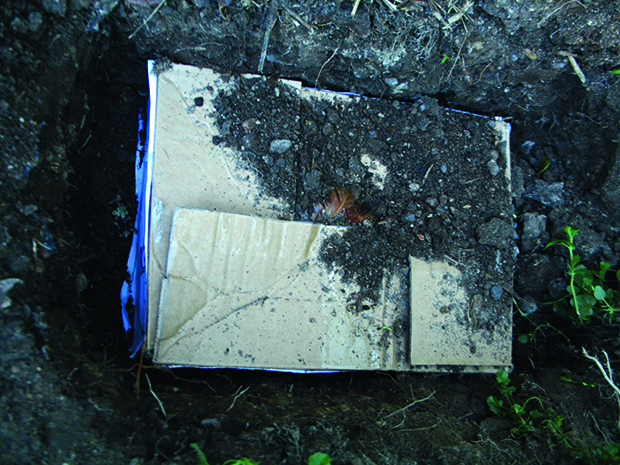
I used to think that the remaining live birds weren’t triggered by seeing the body of their flockmate. But mine kicked up a terrible fuss the last time they spotted me carrying a ginger-feathered corpse. I won’t make that mistake again. An old towel or a sack will disguise the body as you transport it.
You might not hold a funeral, but a burial has the advantage of fertilising the ground. Whatever you plant on top will have a fine spurt of growth. If a vet put down the bird, the carcass must be buried deeply to prevent anything scavenging it and being poisoned as a result.
If your bird was healthy when it was killed, you could use its body to nourish yourselves instead of the soil, but unless the bird is very young it is likely to be strongly flavoured and tough, at least to western palates.
The chicken meat we buy in supermarkets comes from specialised meat breeds that are slaughtered at about six weeks of age, and most people’s taste buds have become accustomed to eating plump, fresh chicken meat.
5. THINK OF THE CHILDREN
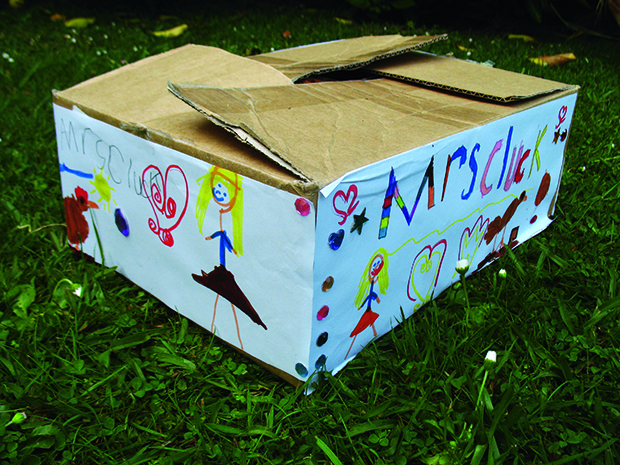
The makeshift coffin for one of my retired hens. Letting your children decorate includes them in the process.
If you have children, grandchildren or any interested young people, you could turn a chicken’s death into a learning experience. You can make the most of those rapidly developing brains and use this opportunity to foster meaning, creativity, curiosity, or an understanding of where food comes from.
Perhaps all, some, or none of these ideas will work for your children. Some might have formed a connection with the animal and be distraught by its death. Some might be horrified, and others might be intrigued. This is not a time to force them to see or do anything.
I’ve had children watch while I did the deed, and I calmly explained what I was doing. They were interested and didn’t seem upset, but there’s no guarantee that will be the case. We shouldn’t prejudge how children will react to witnessing a death if they choose to do so.
Once the bird is dead, you may wish to have a really good look at it in the interest of science. We hardly ever get to perform an undisturbed examination of an animal, yet each one is a sophisticated, intricate result of millions of years of evolution that can prompt a sense of wonder. Can you see different types of feathers, including the tiny, soft, insulating ones closest to the skin? Do you want to pluck some to remember her by, or to make something with? What does the skin look like? Are there bald patches? How are the wing feathers arranged for flight? Check out the dinosaur-like leg scales and toenails. If the head is present and doesn’t look too gruesome, it’s fascinating: comb, wattles, ears, nostrils, tongue. If you’re interested in meat, is there much muscle under the skin?
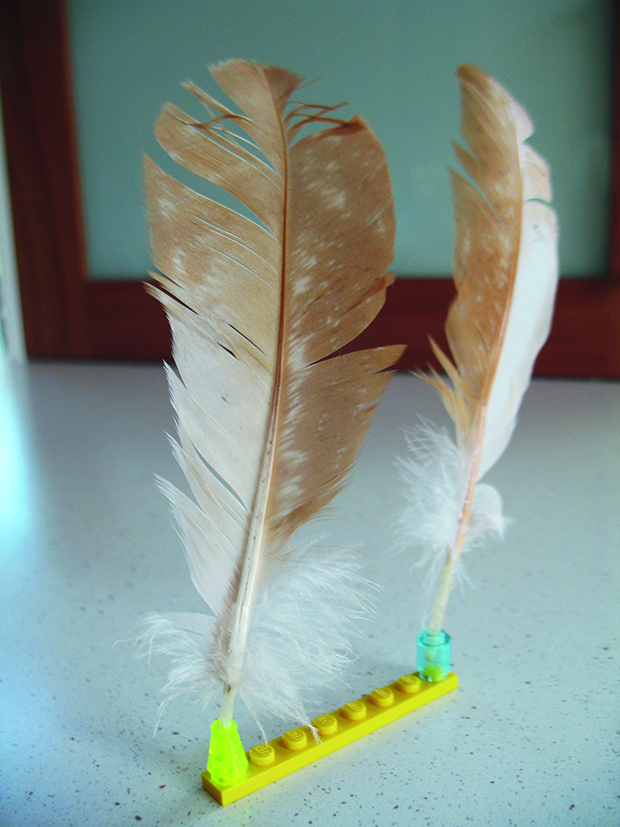
Feathers from a dead chicken – try to view the death as a science or learning experiment.
Does anybody want to draw her? Allow contemplation time.
You or your children may wish to decorate a cardboard box to make a coffin. It’s best to use cardboard and avoid plastic material like glitter and tape that won’t biodegrade post-burial.
You could compose a funeral poem to add ceremony to the occasion. My husband once whipped one up for our black cat:
Ashes to ashes, dust to dust;
Blackgirl was with us, but now she is bust.
Your children may be able to come up with something sweeter. Can anybody play an instrument? Do you want to sing? Is the chicken song inappropriate?
Once the burial is complete, children can help with planting seeds or plants on top if that is the plan. Perhaps there will soon be flowers to pick.
An option for extremely curious children (and I had one) is to exhume the body after a month or so to see what’s left. This wasn’t my idea. But we were amazed: there were a few hollow bones and some feathers, and not much more! Ashes to ashes, dust to dust.
Love this story? Subscribe now!
 This article first appeared in NZ Lifestyle Block Magazine.
This article first appeared in NZ Lifestyle Block Magazine.
